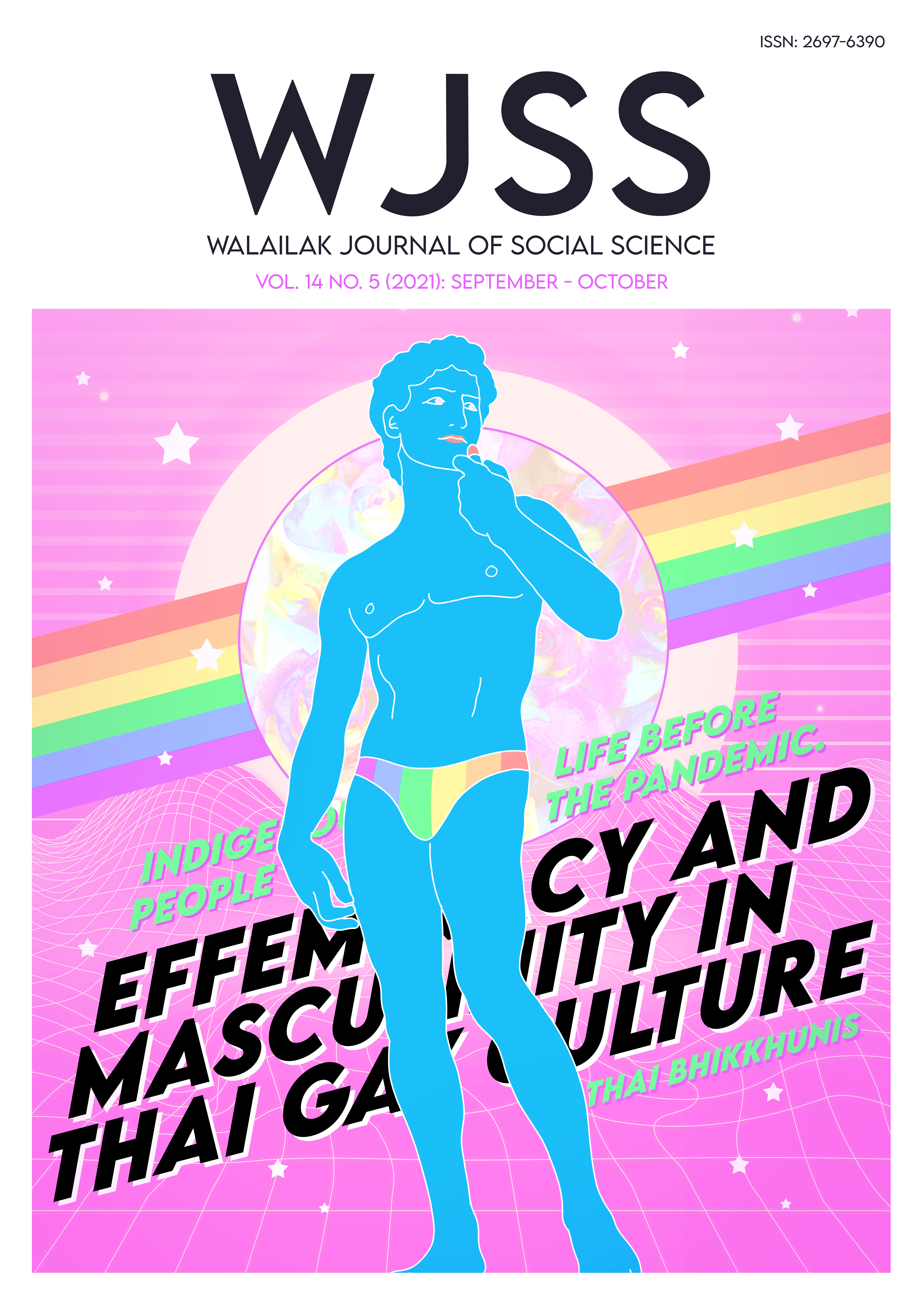Effeminacy and Masculinity in Thai Gay Culture: Language, Contextuality and the Enactment of Gender Plurality
Main Article Content
Abstract
Based on Judith Butler’s account of the performative construction of gender, this study uses a qualitative research method to analyse genderings performed by Thai gay men. The key finding is that Thai gay men are especially flexible in their gender play and performances of both effeminacy and masculinity in the various social situations in their daily lives as well as in their romantic relationships and sexual encounters. In addition to gendered forms of comportment and behaviour, a further important dimension of Thai gay men’s multiple performances of gender is through the use of masculine and feminine forms of language. Thai gay men use gendered language forms to communicate and express both effeminacy and masculinity within their circles of gay friends and acquaintances. This study broadens our understanding of how gay Thai men exhibit differently gendered identities from Western gay men. It also counters the stereotypical negative image by which gay men are often stigmatised and labeled as not being masculine. Thai gay male identity is not based on a firm separation of femininity from masculinity. Rather, alternation between masculine and feminine forms of behaviour and language permits Thai gay men to adapt their public social and private sexual relations according to the different kinds of people they meet and interact with in the different domains of their lives.
Article Details
Copyright: CC BY-NC-ND 4.0
References
Bergling, T. (2001) Sissyphobia: Gay men and effeminate behavior. New York: Harrington Park Press.
Butler, J. (1988). Performative acts and gender constitution: An essay in phenomenology and feminist theory. Theatre Journal, 40(4), 519-531.
Butler, J. (1990) Gender trouble: Feminism and the subversion of identity. New York: Routledge.
Butler, J. (1993) Bodies that matter: On the discursive limits of sex. New York: Routledge.
Chauncey, G. (1994). Gay New York, gender, urban culture, and the making of a gay male world 1890-1940. New York: Basic Book.
Coston, B. M., & Kimmel, M. (2012). Seeing privilege where it isn’t: Marginalized masculinities and the intersectionality of privilege. Journal of Social Issues, 68(1), 97-111.
Duangwises, N. (2010). Mithuna magazine: The norm of middle-class Thai gay men (in Thai). Rattasartsarn, 31(3), 89-132.
Hennen, P. (2008). Fairies, bears, and leatherman: Men in community queering the masculine. Chicago: University of Chicago Press.
Jackson, P. A. & Sullivan, G. (1999). Lady boys, tom boys, rent boys: Male and female homosexualities in contemporary Thailand. Chiang Mai, Thailand: Silkworm Books.
Jackson, P. A. (2003). Performative genders, perverse desires: A bio-history of Thailand’s same-sex and transgender cultures. Intersections: Gender, History & Culture in the Asian Context, 9, 1-52.
Jackson, P. A. (2004a). The Thai regime of images. Sojourn: Social Issues in Southeast Asia, 19(2), 1-39.
Jackson, P. A. (2004b). Phet: An indigenous Thai discourse, why Foucault’s theory of sexuality must be adapted in studying Thai culture. Journal of Language and Culture, 23(1), 57-66.
Jackson, P. A. (2016). First queer voices from Thailand: Uncle Go’s advice columns for gays, lesbians and kathoeys. Hong Kong: Hong Kong University Press.
Jackson, P. A. (2020). Beyond hybridity and syncretism: Kala-thesa contextual sensitivity and power in Thai religious and gender cultures. Journal of Anthropology, Sirindhorn Anthropology Centre, 3(1), 4-37.
Jagger, G. (2008). Judith Butler: Sexual politics, social change and the power of the performative. London: Routledge.
Kantamara, K. (2010). Mae Mai Muay Thai: The art of self-defense. Bangkok: Chulalongkorn University Press
Kawinraweekun, K. (2002). Constructing the body of Thai citizens during the Phibun regime of 1938-1944 (Master’s thesis) (in Thai). Bangkok, Thailand: Faculty of Sociology and Anthropology, Thammasat University.
Kimmel, M. (1994). Masculinity as homophobia. In Brod, H., & Kaufman, M. (Eds.), Theorizing masculinities, (pp. 126-127). Thousand Oaks, CA: Sage.
Malebranche, J. (2006). Androphilia: A manifesto. Baltimore MD: Scapegoat Publishing.
Messner, M. A. (1997). Politics of masculinities: Men in movements. New York: Sage.
Nok-yung. (2008). Can two effeminate gay men be lovers? (in Thai). Retrieved from http://pha.narak.com/topic.php?No=24483.
Reynolds, C. J. (1999). Gendering of nationalist and postnationalist selves in twentieth-century Thailand (pp. 261-274). In Jackson, P. A., & Cook, N. M. (Eds.). Genders and sexualities in modern Thailand. Chiang Mai, Thailand: Silkworm Books.
Saisuwan, P. (2016). Male femininity in Thai among men who identify with non-normative male roles (Doctoral dissertation). School of Languages, Linguistics and Film, Queen Mary University of London.
Taong. (2008). Can two effeminate gay men be lovers? (in Thai). Retrieved from http://pha.narak.com/topic.php?No=24483
Taywaditep, K. J. (2001). Marginalization among the marginalized: Gay men’s anti-effeminacy attitudes. Journal of Homosexuality, 42(1), 1-28.
Van Esterik, P. (1999). Repositioning gender, sexuality, and power in Thai studies (pp. 275-289). In Jackson, P.A., & Cook, N. M. (Eds.). Genders and sexualities in modern Thailand. Chiang Mai, Thailand: Silkworm Books.
Van Esterik, P. (2000). Materializing Thailand. Oxford & New York: Berg.


